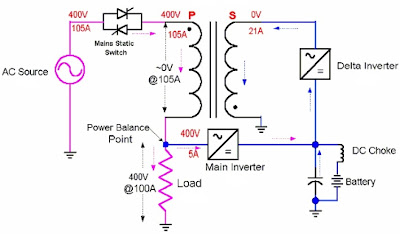Delta
Conversion Online UPS is a modern innovation that eliminates the disadvantages of the traditional double conversion online UPS.
The enhancements are based on having a delta inverter and allowing
bidirectional power flow. Today, this design is the only major uninterruptible power supply technology
protected by patents and is unlikely to be offered from a broad range of UPS
suppliers. Also, delta conversion online units are available in the market from
5 kVA to 1 MVA.
Similarities
and Differences
A. Components
The
delta conversion online UPS differs physically from the conventional design
because of two main components – the delta inverter and delta transformer.
Delta
Inverter
The
delta conversion online UPS has a so-called delta inverter, which is a
current-controlled IGBT Pulse Width Modulator (PWM) inverter. It performs two
major functions:
1. Input power and current regulation
Delta
inverter acts like a variable current source in the secondary circuit of the
transformer, such that it works like a load without power dissipation (except
for switching losses). This active front end draws power that is sinusoidal and
in-phase with the source voltage. Consequently, current magnitude, wave shape and
power factor can be controlled. Thus, with a delta conversion online UPS, the
following can be achieved:
- Reduced heating and system wear in the electrical
power system.
- Minimized harmonics.
- Optimal conditions for utility and generator
systems.
2. Charge
the battery of the UPS
Delta
inverter converts AC voltage to the suitable DC charging voltage.
Delta
Transformer
The
delta transformers in a delta conversion online UPS are actually three
single-phase isolation transformers with one for each phase. Usually, these
transformers have a voltage ratio of 1:5 (primary:secondary). It also follows
that the current ratio is normally 5:1.
B. Power
Flow
In a delta conversion online UPS, both the main and delta inverters are
bidirectional devices, such that they have the capability to transform AC power
to DC power, and at the same time DC power to AC power.
 |
| Delta Conversion Online UPS Block Diagram |
 |
| Double Conversion Online UPS Block Diagram |
The delta conversion online UPS always has the inverter supplying the load during
normal conditions - which is the basic concept of an online UPS. However, the
delta inverter also contributes power to the main inverter output. As a result,
it can deliver power to the loads with much greater efficiency than the double
conversion. Yet, under conditions of AC power disturbances, the delta
conversion online UPS functions just like the conventional design.
C. Benefits
The
delta conversion online UPS provides output characteristics that are similar to
the double conversion online design. Nonetheless, the former can control both
input and output power, which makes possible to gain the following benefits:
- Significant reduction in energy losses
- Makes the UPS compatible with all generator sets
- Reduces the need for wiring and generator oversizing
- Power Factor Correction
To sum
up, the delta conversion online UPS is more efficient since it will directly
deliver power only the difference (delta) between the input and the output.
Under normal conditions, it bypasses the steps wherein AC power is converted to DC
(for battery charging), and transformed back to AC energizing the loads.
Reference:
APC


No comments:
Post a Comment